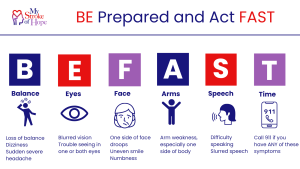A Balanced Heart Is A Healthy Heart
Are you living from the heart? Find out. Take our brief quiz to get your own #LiveFromTheHeart tip sheet.
Take the quiz!
By Stacy Quinn | Posted Mar 6, 2024
Nine years ago, I experienced a medical rarity, and I’ve spent the time since focused on sharing my experience in the hopes of raising awareness about a condition that few people really understand. Unlike a bone break or other easily diagnosed condition, I experienced a carotid artery dissection (CAD), which can cause an array of symptoms that aren’t unique to this condition, such as:
On the more severe side, CADs can cause stroke symptoms including face drooping, dizziness, numbness and difficulty speaking.
Because CADs are rare and can present themselves in many ways, diagnosis is challenging. This has a direct impact on care, which is why there is such a need for increased awareness about them.
Simply put, a CAD is a tear within the wall lining of a carotid artery. The human body has two carotid arteries: one on each side of the neck. Their purpose is to supply oxygenated blood to the brain. When a CAD occurs, the tear lets blood get in between the layers of the wall lining and separates them. This causes the lining to bulge, constricting—even preventing—blood flow. The bulging can also affect other areas if it presses on nearby structures and nerves.
Spontaneous dissections happen without apparent trauma. In many cases, it isn’t possible to determine their cause. Underlying conditions, however, such as connective tissue disorders, high blood pressure and fibromuscular dysplasia can weaken artery walls, increasing their susceptibility to dissection.
Trauma can also cause dissections. Car accidents and sports injuries are common culprits, but even neck manipulation during chiropractic treatment can be risky. That’s because the rapid stretching or twisting of the neck can cause a tear in the artery’s inner lining.
The degree of reduced blood flow to the brain is what causes the range of possible complications. To accurately diagnose a CAD, health practitioners need to be able to see the carotid arteries. Imaging tools (e.g., ultrasound, CT scan, MRI) are good first steps. The most accurate method, however, involves the injection of contrast die into the bloodstream to make blood vessels easier to see.
Once diagnosed, CADs can be treated in several ways, typically determined by severity. The most critical aspect of treatment is restoring proper blood flow. When arteries are narrowed or impeded by clots, blood thinning is a typical first step. In addition to easing blood flood, anticoagulants can help prevent clots and reduce the risk of stroke.
In more severe cases, particularly when the risk of stroke is high, surgery may be needed. There are two surgical options. When possible, doctors may opt to place a stent at the location of the dissection to keep arteries open. These procedures are minimally invasive. In more severe situations, surgeons may seek to repair torn arteries or remove affected sections.
The risk of CAD is low, but everyone is at risk. Three in 100,000 people will have a CAD in their lifetime, but it’s not something that just happens at specific ages or to specific demographics. CADs actually tend to occur more in younger adults than older adults.
You know your body better than anyone. If something doesn’t seem right, put yourself in charge of getting to the bottom of it—no matter what.
Read the original article in its entirety HERE

To learn more about carotid artery dissection and my story visit: www.mystrokeofhope.com.